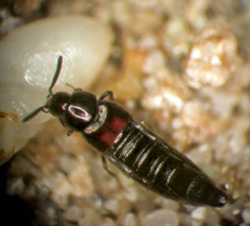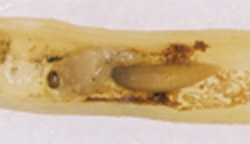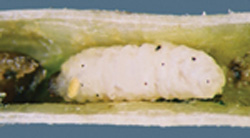
Features
Agronomy
Insect Pests
Natural enemies – farmers’ unpaid helpers
Let them multiply to improve pest control.
November 29, 2007 By Helen McMenamin
Almost every year, an outbreak of some insect pest has farmers somewhere on
the prairies out with sweepnets, counting and worrying that they are losing
their crop to the voracious creatures. Often though, there is unrecognized help
in the sweepnet, perhaps already developing inside the insect you are counting,
or inside the plants.
Insects constantly battle for survival in their bug eat bug world. Pest outbreaks
occur when circumstances allow a species to gain a brief advantage over their
competitors.
 |
| An adult Aleochara bipustulata. It is about two millimetres long. Photo Courtesy Of Kim Riley. |
"On the prairies, we're able to produce crops with very little insecticide.
In some other countries farmers use many times more insecticide on their crops,"
says University of Alberta entomologist, Lloyd Dosdall. "We should market
that great natural advantage and nurture the natural enemies that help us keep
numbers of pest insects down."
Entomologists say all herbivorous insects have natural enemies that can keep
them from dominating an environment for any length of time. Natural enemies
that end pest outbreaks save prairie farmers millions of dollars by making spraying
unnecessary, according to Dosdall. Farmers, he says, have an important role
in letting natural enemies build sufficiently to help in pest control.
"If the populations of a pest insect are high enough, don't hesitate to
spray," says Dosdall. "But, don't spray when pest numbers aren't quite
at the economic threshold.
"By spraying below the economic threshold, you're losing in two ways.
The benefit of eliminating the pest insect won't justify the cost of spraying
and you'll be killing your allies in the battle with the pests. So, scout thoroughly
and don't spray unless populations are above the threshold."
Dosdall also suggests that economic thresholds calculated for canola years
ago may not hold for modern varieties of canola. Not only are today's canola
prices likely to be lower and insecticide treatment costs higher, newer varieties
are much more productive than those available when many threshold numbers were
developed. Newer hybrid canola varieties may be better able to compensate for
insect feeding than older types. It may pay to tolerate a pest that lowers yield
by only a few bushels.
 |
| Larva of cabbage seedpod weevil within a canola pod, largely eaten by the parasitoid larva next to it on the right. Photo Courtesy Of Lloyd Dosdall. |
Diadegma attacks diamondback moth
Sometimes natural enemies can have dramatic effects on insect pest populations.
In 2005, for example, Dosdall saw diamondback moth populations rising, but there
were matching increases in the numbers of their main natural enemy, a parasitic
wasp called Diadegma. In some parts of the US, this little wasp can half
the numbers of diamondback larvae on unsprayed plants.
Predators such as lacewings, plant bugs, pirate bugs and beetles, as well as
spiders and birds, also feed on diamondback larvae. A fungal disease can kill
most of a population towards the end of the summer.
Diadegma lays a single egg in a diamondback moth larva. The Diadegma
larva reduces the diamondback's feeding and consumes it when it pupates. The
parasitic wasps are very sensitive to insecticides and diamondbacks are becoming
resistant in some parts of the world. In some countries, farmers have to spray
vegetable crops up to 15 times a season to control diamondback moths.
Michigan scientists have found Diadegma produce more eggs when they
can feed on wild mustard or yellow rocket early in the year and survive longer
on lamb's quarters and perennial sowthistle. The scientists hope manipulating
these plants around crops can improve biological control of diamondbacks.
Root maggots have their enemies
Canola specialists in the Parkland are seeing a resurgence in root maggots,
15 to 18 larvae per plant were common in 2006. The insects, which originated
in Europe, have been increasing steadily for 30 to 40 years, according to Neil
Holliday, head of entomology at the University of Manitoba. Although five to
10 larvae per plant are typical, some roots have 60 larvae.
Root maggots are the larvae of flies called Delia, which lay their eggs
near the bases of canola plants. After hatching, larvae move into the roots
out of reach of insecticides, so entomologists are working on biological controls.
Delia flies lay fewer eggs when weeds grow among the canola plants, so
intercropping canola with a cereal or leaving some weeds can reduce the infestation.
 |
| Larva of an Aleochara bilineata chewing an entrance hole in a root maggot pupal case. The pupal case (of which about two-thirds is visible) is about six millimetres (1/4 inch) long. Photo Courtesy Of Kim Riley. |
A rove beetle, Aleochara bilineata, attacks root maggots. The adults
feed on root maggot eggs and lay their eggs near the puparia. The larvae break
into the puparia, seal off the hole they have made, feed on the contents and
then pupate inside the root maggot pupal case. On the prairies, Aleochara
bilineata and a second parasite, which is a small wasp, together parasitize
about 40 percent of root maggot pupae.
In Europe, a second Aleochara species also attacks the root maggot,
increasing the level of parasitism. Holliday has been working to verify that
the European species enhances the effect of Aleochara bilineata and does
not attack any native or beneficial species, in the hope he can import and release
it.
In field cages, the two species together attacked more root maggot puparia
than the same number of either species alone. Holliday has focussed on the parasitism
because other predatory insects feed on the eggs.
"Beetles, and other predatory insects, generally feed on something on
their own scale," Holliday says. "The big heavy beetles common in
crop debris eat bertha armyworms, diamondback larvae, earthworms, slugs and
snails and sometimes each other. Smaller rove beetles, ground beetles and other
insects a few millimetres long, feed on insect eggs."
It is estimated that up to 70 percent of root maggots are eaten by predators
and 40 percent of the survivors are killed by parasites. They also die due to
weather and misadventure so that total mortality could reach 98 percent of the
50 to 200 eggs a pair can produce. Despite these losses, says Holliday, root
maggots continue to thrive, highlighting the need for more control.
 |
| Larva of cabbage seedpod weevil within a canola pod. The black marks indicate where a female of Necremnus stung the larva to paralyze it. The yellow, oval-shaped body just to the right of the weevil head is the egg laid of Necremnus, which will hatch to form a larva that will eat away on the contents of the weevil. Photo Courtesy Of Lloyd Dosdall. |
The European Aleochara parasitizes onion maggots as well as the species
found in canola, but no other prairie species, so Holliday is optimistic about
getting permission to release the insects.
His next challenge will be to find a line of Aleochara bipustulata that
will lay eggs here when root maggots have started to pupate. He will also have
to raise significant numbers of the insect for release. He is ready for the
challenge of releasing insects. He has found an extract of mustard can keep
the beetles in a small area, so they will be able to find one of the few available
mates.
If he is permitted to release European Aleochara, Holliday expects to
have insects ready for release in about five years, about 13 years after he
started work on the root maggot problem. He notes that the progress owes a great
deal to the efforts of staff at CABI in Switzerland. Under a special funding
arrangement with Agriculture Canada, CABI helps scientists here find solutions
to issues related to insect pests that occur elsewhere in the world. The efforts
of scientists working in Europe and Canada have led to successful biological
control of some very costly weeds and pests.
Lygus bug parasitoids coming to the rescue
Scientists are also considering releasing a European parasitoid of lygus bugs
that is already in eastern Canada. Lygus bugs prefer alfalfa fields and only
move into canola after haying. On the prairies, their parasitoids do not move
with them. Entomologists are hoping a European parasitoid imported into the
US will be more amenable to moving to canola fields with the lygus.
Parasitoids of cabbage seedpod weevil could be the poster child for natural
enemies. The weevil is not becoming as severe a pest as entomologists initially
expected because, although it is an invasive alien species, some of our native
species have adapted to feed on it. Parasitoids have increased 50-fold in the
last few years.
Two types of native insect are competing to feed on cabbage seedpod weevil,
but eventually Dosdall expects one will dominate. Necremnus wasps find
weevil larvae inside canola pods with their spectacular antennae. (The males
have similar antennae they use to excite females during mating.) The female
injects a paralytic venom into the weevil larva, then lays an egg in it. When
the Necremnus larva emerges, it feeds on the still-paralyzed weevil larva.
Another native wasp, Trichomalus, is closely related to a wasp that
parasitizes cabbage seedpod weevil in Europe. It has also switched to attacking
the pest and Dosdall suspects it may come to be the dominant parasitoid.
There may be a downside to native parasitoid adapting to a new insect. The
natural host may suffer less parasitism and increase unchecked. Scientists have
not been able to find the natural host of Trichomalus. Necremnus
attacks a weevil that feeds on flixweed seeds.
Other pests are not heavily parasitized until late in an outbreak. Dosdall
saw increasing bertha armyworm numbers in 2006 and some fields had to be sprayed,
but he did not find any indication of attacks by the wasp that parasitizes them.
He says it usually takes two years of high host populations for wasp numbers
to increase enough to end the outbreak.
Editor's note
Production of natural enemies has been taken on commercially near Thika,
Kenya, where Real IPM has more than 25 acres of plastic tunnel greenhouses
used to produce natural enemies on host plants. Led by entomologist Louise
Labuschagne, the company is gaining a reputation by helping train consultants
in other parts of the world. For more information, visit www.realipm.com